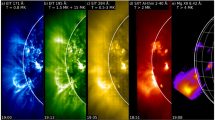Abstract
MANY studies of the Crab have shown that it is exceedingly difficult to understand its evolution and its high-energy particle content on the assumption that all the energy was injected at the time of the outburst of the supernova about 103 yr ago. Evidence of continuous activity is provided directly by the moving wisps (private communication from W. Baade, a preprint by J. Scargle and ref. 1) and the suggestion that some parts of the flux of high-energy electrons responsible for the radio and optical synchrotron radiation have lifetimes which are short compared with the time which has elapsed since the explosion. If all the energy released in a supernova explosion is emitted during the outburst and if the high-energy particles were generated in this way2, the continuous activity would not be explained. But there are now a number of lines of evidence each of which suggests that condensed supernova remnants are present, and it is these which probably maintain the overall activity in the Crab. We outline the arguments which lead to this conclusion.
Similar content being viewed by others
References
Oort, J. H., and Walraven, T., Bull. Astron. Insts. Neth., 12, 285 (1956).
Colgate, S., and Johnson, M. H., Phys. Rev. Lett., 5, 235 (1960). Colgate, S., and White, R. H., Astrophys. J., 143, 626 (1966).
Hewish, A., and Okoye, S. E., Nature, 207, 59 (1965).
Rees, M. J., Astrophys. Lett., 2, 1 (1968).
Demoulin, M-H., and Burbidge, G., Astrophys. J., 154, 3 (1968).
Staelin, D. H., and Reifenstein, E. C., Science, 162, 1481 (1968).
Gold, T., Nature, 218, 731 (1968).
Bowyer, S., Byram, E. T., Chubb, T. A., and Friedman, H., Science, 146, 912 (1964).
Peterson, L., Jacobson, A., Pelling, R., and Schwartz, D., Canad. J. Phys., 47, 437 (1968).
Oda, M., Bradt, H., Garmire, G., Spada, G., Sreenkantan, B. V., Gursky, H., Giacconi, R., Gorenstein, P., and Waters, J. R., Astrophys. J., L5 (1967).
Tucker, W. H., Astrophys. J., 148, 745 (1967).
Hoyle, F., and Fowler, W. A., Quasi-Stellar Sources and Gravitational Collapse, 17 (Univ. Chicago Press, 1965). Hoyle, F., Fowler, W. A., Burbidge, G. R., and Burbidge, E. M., Astrophys. J., 139, 909 (1964).
Burbidge, G. R., Nature, 216, 1287 (1967).
Author information
Authors and Affiliations
Rights and permissions
About this article
Cite this article
BURBIDGE, G., HOYLE, F. Condensed Objects in the Crab Nebula. Nature 221, 847–848 (1969). https://doi.org/10.1038/221847a0
Received:
Issue Date:
DOI: https://doi.org/10.1038/221847a0
- Springer Nature Limited
This article is cited by
-
?Time-integrated? synchrotron radiation in high-energy astrophysics
Astrophysics and Space Science (1975)
-
Dust in the Crab Nebula
Nature Physical Science (1971)
-
Measurement of the 10 µm Flux from the Crab Nebula
Nature Physical Science (1971)
-
Doppler period variations of high-velocity pulsars
Astrophysics and Space Science (1971)
-
Low-frequency Spectrum of the Crab Nebula
Nature (1970)





